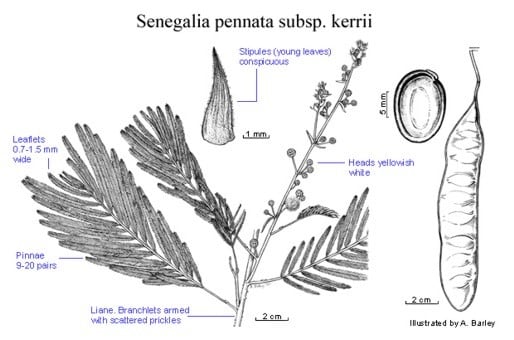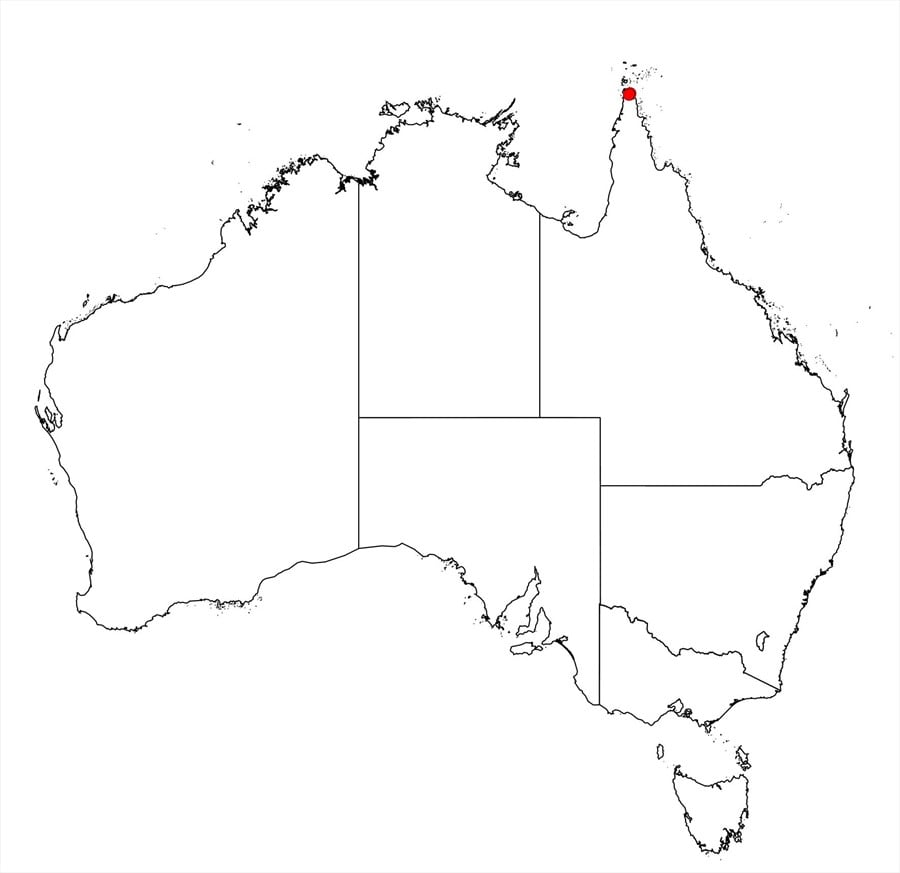Senegalia pennata subsp. kerrii (I.C. Nielsen) Maslin
WATTLE
Acacias of Australia
Common Name
Climbing Wattle
Family
Fabaceae
Distribution
Found on the tip of Cape York Peninsula, Qld. Also occurs in north-eastern India, Burma, Cambodia, Laos, North and South Vietnam and the Lesser Sunda Islands (Sumbawa and Timor).
Description
Liane. Branchlets with scattered prickles. Stipules of young leaves enveloping flower buds, broadly ovate and tapering, to 0.9 cm long, conspicuously longitudinally nerved, puberulous, somewhat hooded. Leaves: petiole 2–4 cm long, with a flattened elongated gland situated immediately or shortly above pulvinus; rachis 6–22 cm long, with scattered prickles on lower surface, densely clothed with erect to patent hairs on upper surface (also on pinna-rachis), with a flattened gland present at or near junction of each of top 1–3 pairs of pinnae; pinnae 9–20 pairs; pinnules 25–60 pairs per pinna, obliquely linear-oblong, 3–7 mm long, 0.7–1.5 mm wide, acute, glabrous or ciliate, with midrib excentric basally and nearly central above. Inflorescences capitate, axillary, racemosely or paniculately arranged. Flowers yellowish white. Calyx glabrous except apices of lobes. Pods oblong, (10–) 14–16 cm long, 2.1–2.6 cm wide, coriaceous, dehiscent. Seeds elliptic, 9–11 mm long, 6–8 mm wide, c. 2 mm thick, brown; areole distinct.
Habitat
In Qld, it occurs in or on the margins of rainforest.
Specimens
Qld: between Bamaga and Lockerbie, B.Gray 4299 (MEL, QRS); Laradeenya Ck, B.Hyland 21051V (BRI, MEL, NSW, QRS); Lockerbie, B.Hyland 21049V (QRS).
Notes
Based on molecular and other data Acacia sens. lat. is now considered as comprising a number of segregate genera, see J.T.Miller & D.S.Seigler, Austral. Syst. Bot. 25: 217-224 (2012) for overview. Many taxa in the former Acacia subg. Aculeiferum are now referable to the genus Senegalia, including the one presented here.
Distinguished readily from S. albizioides in that the leaves have more numerous pinnae and pinnule pairs, smaller pinnules, conspicuous stipules and longer and broader pods.
FOA Reference
Data derived from Flora of Australia Volumes 11A (2001), 11B (2001) and 12 (1998), products of ABRS, ©Commonwealth of Australia
Author
Revised by B.R.Maslin
J.H.Ross
This identification key and fact sheets are available as a mobile application:
URL: https://apps.lucidcentral.org/wattle/
© Copyright 2018. All rights reserved.









